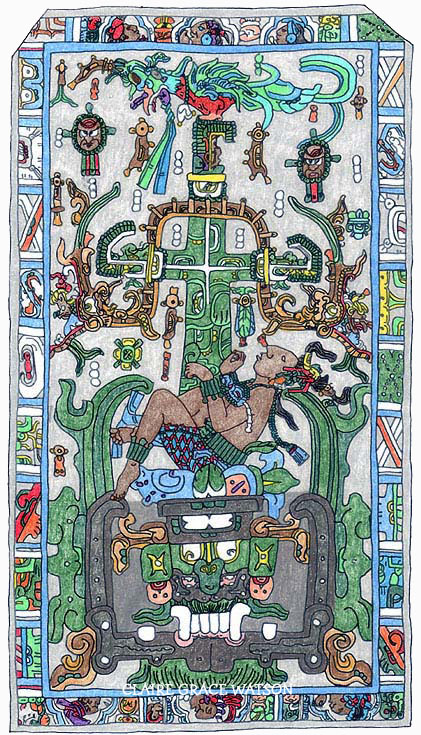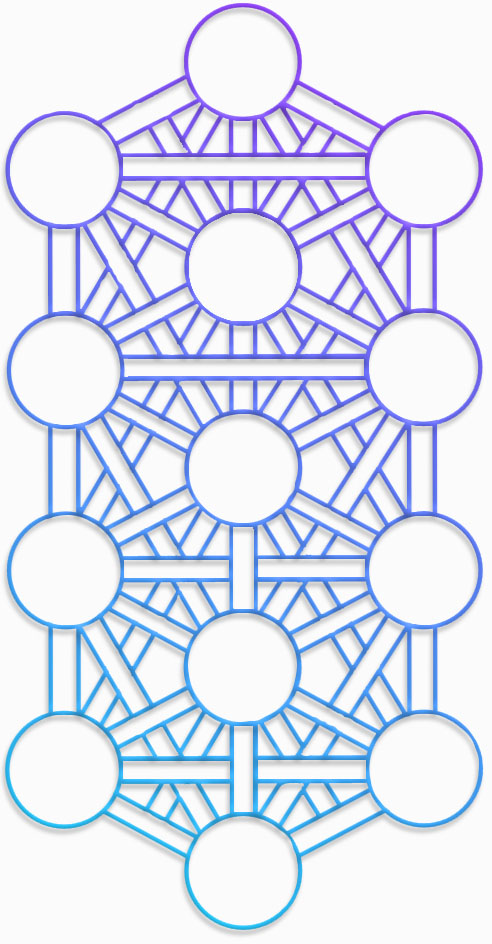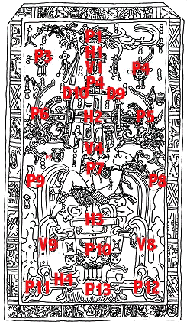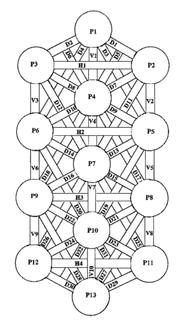Unpacking and publishing the Phaistos Disk since 1993
HOME PREVIOUS NEXT SITEMAP

The 5-ton stone slab, the most remarkable burial artifact ever unearthed in the Americas, has been identified as an astronaut in a space ship and as a man falling into the underworld and being swallowed by the jaws of death. I think the Sarcophagus shows a man who is aware of his own immortality and who knows he will be regenerated after death and transformed into divinity. This tomb carving of his explains the processes as he understands them.
Lord Pacal, the great Mayan king, was entombed in 683 CE under the seventy-five foot high Temple of Inscriptions in Palenque, Mexico. In 1952, after three seasons of work removing the rubble and boulders that had been pushed down the tunnel, archeologists found a 30 ft. long x 13 ft. wide burial chamber at the bottom. It contained a 12-ft. long x 7-ft. wide carved slab that appeared to be the floor. Archaeologists described the interior of the corbel vaulted tomb as a "fantastic, ethereal sight, a huge magic grotto carved out of ice, the walls sparkling and glistening like snow crystals. Stalactites hung like tassels of a coat and the stalagmites on the floor looked like the dripping from a great candle."
The lime issuing from the walls and ceiling created these startling visual effects. When the archeologists lifted the slab from the coffin, they were met once again with a fantastic sight as they gazed upon the Great Green of the Cosmic Ocean - the thousand pieces of jade covering the king's body.
"The great man - he was probably a priest - had no gold ornaments, but here were quantities of jade objects-beads, rings on every finger, bracelets, ear ornaments, and exquisitely carved figurines. These were in the form of flowers, little gourds, bats, snakes and heads, and figures with the characteristics of certain Mayan gods. The buried man had a jade ornament in each hand and another in his mouth; his neck and shoulders were covered with a huge collar and breast ornament of jade beads. On his face were the remains of a mask of jade mosaic."
The explanation that is currently offered regarding the ocean of jade that covered the king is that he was a great king, highly esteemed by his subjects. There may be another reason for the quantity of jade, one more complex and fascinating.
 The Sarcophagus of Lord Pacal could be the king's expression, within the context of a single, unified, conceptual construct, of the World Soul that contains his own individual soul. When art and artifacts finely depict cosmic truths, many interpretations become possible. With that in mind, the offered interpretation here is that this artifact, along with the others contained in this book, show varying portrayals of the diagram called herein the World Soul (my version, the completed lightmatrix tree, left), which was constructed based upon the ancient Kabala Tree of Life. Therefore, the Sarcophagus of Lord Pacal, the Shroud of Turin, the Maze of Daedalus and many more identical, hidden patterns found in art and collected in this book are interpreted to show that glyph.
The Sarcophagus of Lord Pacal could be the king's expression, within the context of a single, unified, conceptual construct, of the World Soul that contains his own individual soul. When art and artifacts finely depict cosmic truths, many interpretations become possible. With that in mind, the offered interpretation here is that this artifact, along with the others contained in this book, show varying portrayals of the diagram called herein the World Soul (my version, the completed lightmatrix tree, left), which was constructed based upon the ancient Kabala Tree of Life. Therefore, the Sarcophagus of Lord Pacal, the Shroud of Turin, the Maze of Daedalus and many more identical, hidden patterns found in art and collected in this book are interpreted to show that glyph.
According to the symbolism displayed on the sarcophagus, Lord Pacal may have believed the cosmos was preceded by a time when Nothing Existed. This Nothing, which Existed before the material universe was emanated and before anything existed in the sense that we think of as existence, was "That One Thing, breathless, breathed by Its own nature: Apart from It was nothing whatsoever." (2) In Egypt, That One Thing was characterized as That-Which-Is, a "darkness beyond all conception, a thrice unknown darkness." (3) In this Nothing, Creator and Created, Thinker and Thought, Mind and Idea existed in the Primal Realm of Silence, in the primordial state of unindifferentiation, where no bonding was experienced because no individuation existed. The Primal Realm of Silence is portrayed on the top portion of the Sarcophagus, as recorded in the Mayan creation myth of the 16th century CE, 800 years after the Sarcophagus and the Temple of Inscriptions were completed.
"Before the world was created, Calm and Silence were the great kings that ruled. Nothing existed, there was nothing. Things had not yet been drawn together, the face of the earth was unseen. There was only motionless sea, and a great emptiness of sky. There were no men anywhere, no birds or fish, no crabs. Trees, stones, caves, grass, forests, none of these existed yet. There was nothing that could roar or run, nothing that could tremble or cry in the air. Flatness and emptiness, only the sea, alone and breathless. It was night; silence stood in the dark. In this darkness the Creators waited, the Maker, Tepeu, Gucamatz, the Forefathers. They were there in this emptiness, hidden under green and blue feathers, alone and surrounded with light. They are the same as wisdom. They are the ones who can conceive and bring forth a child from nothingness."


Within this context, the child brought forth is Lord Pacal. Atop Pacal's sarcophagus (left) is the green and blue Quetzal bird, the sacred bird. This is Portal 1 (P1) on the World Soul (left [Illus. 2]). Hidden under the green and blue feathers of the sacred bird are the round faces of the Forefathers, P2 and P3, who are "the same as wisdom." Horizontal 1 (Hl) joining P2 and P3, is only partially defined. The sacred bird, having emanated it, stands on a little section of it. If this Quetzal bird is turned upside-down, so that its head dips into the area of V1 just below H1, then we can see the same concept as the one shown by the falcon that pierces the limit in the papyrus text. Just as the falcon regenerates the individual, so does the Quetzal regenerate Lord Pacal.
Vertical 1 (Vl), which begins the vertical pillar (the Central Pillar and world axis) of Pacal's World Soul, extends to a small semicircle, hidden Portal 4 (P4). All the P4 area and above are on the other side of the Limit and in the realm of Mind and Idea, where "the Creators waited, the Maker, Tepeu, Gucamatz, the Forefathers. They were there in this emptiness, hidden under green and blue feathers."
Just beneath hidden P4 is a large ruffled and curving bar, D9 and D10, which is a serpent. The serpent, a Mayan symbol of polarity, is the lifted electromagnetic Curtain, lifted above the Limit-Cross (intersection of H2-V4), separating the material world from the nonphysical world of the Maker.
"He created the curtain between the immortals and those that came afterward."
The lower curvatures of the serpent-Curtain are joined to elaborate, ethereal portals, P5 and P6, the gaping jaws of the serpents, from out of which the maize gods emerge. This elaboration spreads to the outer edge of the lid, to the margins containing the hieroglyphs that tell of Lord Pacal's family and ancestors. Beneath the ruffled serpent-Curtain is a short vertical section, V4, that intersects H2, which is the horizontal plane connecting P5 and P6. This is the Limit-Cross. In this ethereal world reside the subtle energy systems (the Forms) which are the blueprints of the physical forms taken by living matter. Within these portals, and in support of the Forms, are the Energy-Intelligences--the occult Forces of the Mayan world. Here reside the maize gods, nestled within kernels of corn.
The Mayan connection of the maize with jade stone is not easy to understand, but it is not as mind-boggling as the ancient Egyptian connection of the beetle to the sky. The Mayas deified the Spirit of the maize, their main source of food, and regarded it reverentially with love. Maize is the gift of the gods. The jade stone is the Mayan symbol for the ear of corn before it ripens. They say the green corn, green like jade, is hidden within the stone. When the stone is smashed, the maize is born and becomes divine. The Mayas believe the jade and the corn are different but complementary aspects of the same form or archetype. When the Mayas placed Lord Pacal's body inside his Sarcophagus beneath the temple and covered him with jade, he became like the maize gods, "hidden within the stone, hidden within the night." After his death, Pacal, the jade and the maize gods, all different but complementary aspects of the same form, all returned to oneness. At the time of that return, Pacal acceded to his divinity, as portrayed on the Sarcophagus. Lord Pacal, wearing kernels of corn and long hair like the maize gods, long and flowing like corn silk, is shown rising from his coffin. He is regenerated and is rising from death to rebirth within the pantheon of Mayan gods.
"Three, seven, eight thousand was the creation of the world, when he who was hidden within the stone, hidden within the night was born."
The Mayas say there are two universes, the universe of heaven (The Boundless Light and Mind) and the universe of earth (Idea and Energy-Matter) to create the unity of the World Soul. The Chinese call these the Earlier Heaven (universe of heaven) and the Later Heaven (universe of earth). In the Mediterranean Bronze Age, these universes are seen as side 1 and 2 of the Phaistos Disk (see above). Side 1 is Heaven and Earth, side 2 is Hades and Tartarus. These two worlds in Gnosticism, the idea derived from the ancient Egyptian sect of Osiris, are the Ogdoad and the Hebdomad. The Earlier Heaven is the Ogdoad, the Eighth Sphere (P7 and above), and the Later Heaven is the Hebdomad, the lower seven spheres of the planets (P7 and below). On the World Soul, these two macrocosms merge at Portal 7 (P7), the pivotal sphere. Perhaps Lord Pacal believed that he existed midway between these two universes, with his feet firmly planted on the earth and with his head and heart in heaven. On the Sarcophagus he is seen midway between these two universes, where they intersect at Portal 7. In order to fit himself in that position, he designed the image on the sarcophagus so that V4 is extended below H2.
Pacal is enthroned on a raised H3, just above the water-lily monster (P10). H3 joins P8 and P9, two portals Pacal portrayed as flowing up vertically, lifting him from his coffin. His head rests on a section of P8. With his left foot he points to P9's old location. With his right foot he points to P9's new location, where it is shown as a stylized semicircle. At Portal 7 Lord Pacal, Generation 7 of Divine Palenque Lords, carved his hands in the shape of a lemniscate, symbolizing infinity. P7 is shown in detail to the left of his hands, where it is the circle with the two intersecting diagonal paths, D13, D14, D15 and D16.
H3 and H4 mark the top and bottom of the golden rectangle that is the portrayal of the coffin beneath the slab. The coffin is adorned by the water-lily monster, P10, bounded on the right by V8 and on the left by V9. At the bottom of the coffin beneath the water lily monster is P13, now in the center of H4. P13 is raised so that the coffin part of the carving is squared at the bottom as it should be and not triangular. Coffins are not triangular.
H4 joins P11 and P12, the bottom right and left corners of the representation of the coffin. On this physical plane of P11, P13 and P12 are the human remains of the great Mayan King. P11 and P12 are not "Ca-bala" (Mayan word meaning "two hidden,") as they are on some of the World Soul designs in this book but are stated spheres. They also are not "Ca-bala" on the Shroud of Turin.
Lord Pacal is the Divine Child brought forth from nothingness by the Maker, in the same way that Osiris was born from the chaos of Rhea's Womb, having been sorted out by Thoth (Time). Pacal is the boy who became the great Mayan king, the man who became the brilliant mystic. As a 12-year-old on the Jaguar Throne, he received the crown from his mother, Lady Zac-Kuk. Lord Pacal lived to age 80, then ascended the spheres on his return journey home.
Lord Pacal gained a privileged position vis-a-vis the universe from which he accessed the realities ordinarily hidden by the Curtain and the Limit-Cross. He asserted in hieroglyphs that he was 8 Ahau, Lord #8 in the series of Divine Palenque Lords who incarnate to guide civilization. His name means Hand Shield. He and his culture believed he came to earth as humanity's shield, as civilization's protector. The horizontal figure 8 position of his hands seconds his assertion that he is 8 Ahau; the location of his head in P8 thirds it; and his symbolic death at age 80 affirms it. The 8 symbolism is further extended by the 8 outer spheres of Pacal's Sarcophagus/World Soul, identifying him, as the ancient Egyptian priests and priestesses of Isis would say, a resident of Thoth's celestial City of 8 Gods - the Ogdoad - whose gods are male and female, light and dark, positive and negative.
"I was born like a lily in the garden, and so also was I brought up. As my age came, I have grown up. And, as I had to die, so I dried up. And I died."
Footnotes: 1. Alberto Ruz; 2. Sri Krishna Prem, Creation Myth; 3. Damascius, On First Principles; 4. Popul Vuh; 5. The Sophia of Jesus Christ, the Nag Hammadi Papyri
Illustrations: All Illustrations are by the author. 1. The Sarcophagus of Lord Pacal, color added; 2. The World Soul glyph created by Claire Grace Watson, MST; 3. Pacal and Chan Bahlum, after Mayan art, color added
Copyright Notice - Disk of the World - Text and images copyrighted March 21, 1993-2025, Claire Grace Watson, B.A., M.S.T., U.S. Copyright and under the Digital Millennium Copyright Act of 1998, All rights reserved. No part of this web page may be reproduced or transmitted in any form or by any means without written permission from the author, except for the inclusion of brief quotations in a review.